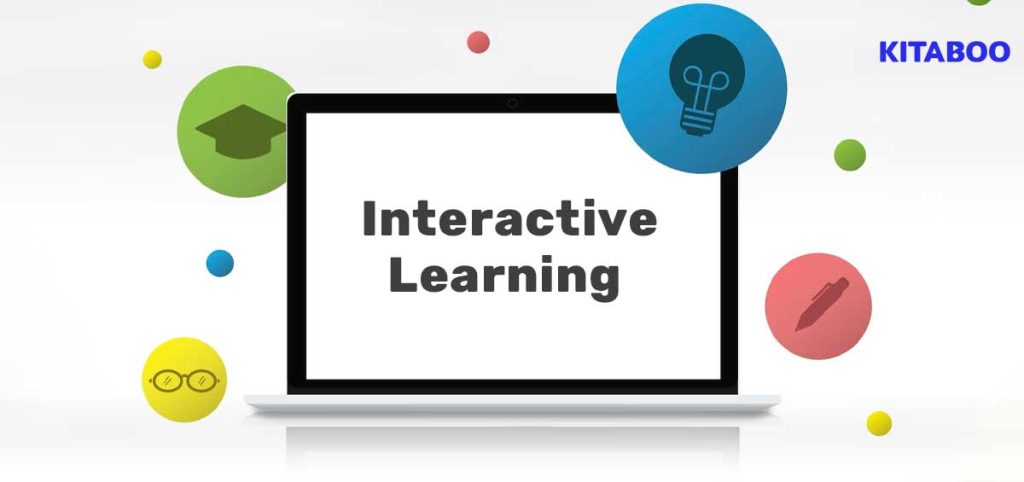
Interactive Learning: Transforming K12 Education for the Digital Age
Summarize this blog with your favorite AI:
The world is changing rapidly, and so is the way we learn. Technology has opened up new possibilities for education, making it more accessible, engaging, and personalized. However, not all educational content is created equal.
Some content is still based on outdated methods and formats that do not cater to the needs and preferences of modern learners. That’s why interactive learning is becoming more popular and essential for K12 education.
Interactive learning is a pedagogical approach that involves active participation and collaboration between students and teachers, using digital tools and resources to create immersive and meaningful learning experiences.
In this blog, we will explore what interactive learning is and why it is important for K12 education. We will also introduce you to KITABOO, a cloud-based digital publishing platform catering mainly digital textbooks, to help you create and distribute interactive content for K12 education.
Table of Contents:
I. What is Interactive Learning?
II. Why is Interactive Learning Important for K12 Education?
- Increases Student Engagement and Motivation
- Enhances Student Outcomes and Retention
- Promotes Collaboration and Communication
- Supports Differentiation and Personalization
- Fosters a Positive Learning Environment
III. How Can Interactive Learning Transform K12 Education for the Digital Age?
IV. What are the Benefits of Interactive Learning for Students and Teachers?
V. Conclusion
What is Interactive Learning?
Interactive learning is a way of teaching and learning that involves the active participation of students and teachers. It uses different methods and technologies to make learning more engaging and meaningful.
Interactive learning can help students develop critical thinking, problem-solving, and communication skills. It can also make learning more fun and relevant to real-life situations.
Some examples of interactive learning are:
- Working in groups or pairs on projects or tasks
- Using computer programs or online games to practice skills or explore topics
- Participating in discussions or debates with peers or experts
- Creating products or presentations to demonstrate learning
- Conducting experiments or investigations to discover new knowledge
Why is Interactive Learning Important for K12 Education?
Interactive learning is important for K12 education because it can:
Increases Student Engagement and Motivation
Interactive learning makes students the center of the learning process, making them active participants rather than passive recipients. This can boost their interest, curiosity, and enthusiasm for learning.
Enhances Student Outcomes and Retention
Interactive learning allows students to apply their knowledge, skills, and creativity to solve problems, create products, or perform tasks. This can deepen their understanding, improve their memory, and foster higher-order thinking.
Promotes Collaboration and Communication
Supports Differentiation and Personalization
Interactive learning enables teachers to tailor the instruction to the needs, preferences, and abilities of each student. This personalization can increase the relevance, accessibility, and effectiveness of the learning experience.
Fosters a Positive Learning Environment
Interactive learning creates a culture of inquiry, exploration, and discovery in the classroom. This can enhance the student’s confidence, self-efficacy, and enjoyment of learning.
How Can Interactive Learning Transform K12 Education for the Digital Age?
Interactive learning can transform K12 education for the digital age by:
- Providing access to a wide range of high-quality content that can be customized and updated according to the curriculum standards.
- Enabling anytime, anywhere learning that can be accessed on various devices such as laptops, tablets, smartphones, or smart TVs.
- Supporting personalized learning that can adapt to the individual needs, interests, goals, and abilities of each student.
- Empowering teachers to create, curate, modify, and share interactive content with their students using easy-to-use tools and platforms.
- Enhancing classroom instruction by integrating interactive content with other teaching strategies such as flipped classroom, blended learning, project-based learning, inquiry-based learning, etc.
- Encouraging parental involvement by providing parents with access to their children’s progress reports, feedback, assignments, etc.
What are the Benefits of Interactive Learning for Students and Teachers?
Interactive learning can offer many benefits for students and teachers alike. Some of these benefits are:
For Students:
- Increased Engagement: Students are more likely to pay attention, participate, ask questions, explore ideas, etc., when they are involved in interactive learning activities.
- Improved Retention: Students are more likely to remember what they learn when they interact with the content in multiple ways (e.g., reading, listening, watching, doing).
- Enhanced Comprehension: Students are more likely to understand what they learn when they receive immediate feedback, explanations, hints, etc., from interactive content.
- Applied Knowledge: Students are more likely to apply what they learn when they have opportunities to practice their skills in realistic situations or contexts through interactive content.
- Developed Skills: Students are more likely to develop 21st-century skills such as creativity, problem-solving, communication, collaboration, digital literacy, and global citizenship when they engage in interactive learning activities.
For Teachers:
- Reduced Workload: Teachers can save time and effort by using ready-made or easily customizable interactive content from various sources and platforms.
- Increased Flexibility: Teachers can adjust the content according to the learning objectives, student needs, class size, time constraints, etc.
- Enhanced Feedback: Teachers can monitor student performance, progress, and behavior using analytics and reports from interactive content.
- Improved Communication: Teachers can communicate with students and parents using interactive content platforms that support messaging, commenting, sharing, etc.
- Expanded professional development: Teachers can learn new skills, techniques, and best practices from other teachers and experts using interactive content platforms that offer training, support, and community.
Want to create and distribute interactive content for K12 education? Get help with KITABOO! KITABOO is a platform that helps you create and distribute interactive digital content and eBooks for K12 education.
You can use it to make your content more engaging and accessible with multimedia, interactive features, and customization options. You can publish your content in various formats that can be viewed online or offline on different devices.
Also Read: Best Ebook Creation Software
Conclusion
Interactive learning is a powerful way to transform K12 education in the digital age. It can enhance student engagement, outcomes, and skills, as well as provide teachers with flexibility, feedback, and professional development.
Create immersive and meaningful learning experiences for your students that will prepare them for the future with KITABOO. To learn more about KITABOO – the leading digital textbook platform and how it can help you with your interactive learning needs, contact us now!
Suggested Reads:
Discover how a mobile-first training platform can help your organization.
KITABOO is a cloud-based platform to create, deliver & track mobile-first interactive training content.



